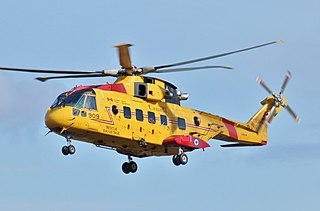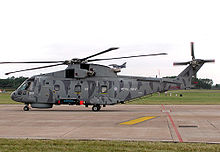Westland Helicopters was a British aircraft manufacturer. Originally Westland Aircraft, the company focused on helicopters after the Second World War. It was amalgamated with several other British firms in 1960 and 1961.

The Sikorsky SH-3 Sea King is an American twin-engined anti-submarine warfare (ASW) helicopter designed and built by Sikorsky Aircraft. A landmark design, it was one of the first ASW rotorcraft to use turboshaft engines.

The Sikorsky SH-60/MH-60 Seahawk is a twin turboshaft engine, multi-mission United States Navy helicopter based on the United States Army UH-60 Black Hawk and a member of the Sikorsky S-70 family. The most significant modifications are the folding main rotor blades and a hinged tail to reduce its footprint aboard ships.

The Westland WS-61 Sea King is a British licence-built version of the American Sikorsky S-61 helicopter of the same name, built by Westland Helicopters. The aircraft differs considerably from the American version, with Rolls-Royce Gnome engines, British-made anti-submarine warfare systems and a fully computerised flight control system. The Sea King was primarily designed for performing anti-submarine warfare (ASW) missions. A Sea King variant known as the Commando was developed by Westland to serve as a troop transport.

Iroquois-class destroyers, also known as Tribal class or DDG 280 class, were a class of four helicopter-carrying, guided missile destroyers of the Royal Canadian Navy. The ships were named to honour the First Nations of Canada.

The AgustaWestland AW101 is a medium-lift helicopter in military and civil use. First flown in 1987, it was developed by a joint venture between Westland Helicopters in the United Kingdom and Agusta in Italy in response to national requirements for a modern naval utility helicopter. Several operators, including the armed forces of Britain, Denmark, and Portugal, use the name Merlin for their AW101 aircraft. It is manufactured at factories in Yeovil, England, and Vergiate, Italy. Licensed assembly work has also taken place in Japan and the United States.

The AgustaWestland CH-149 Cormorant is the Canadian Forces designation for the AgustaWestland AW101, a helicopter used for air-sea rescue in Canada. Developed from AgustaWestland in Italy, the CH-149 is a medium-lift helicopter for military applications.

Agusta was an Italian helicopter manufacturer. It was based in Samarate, Northern Italy. The company was founded by Count Giovanni Agusta in 1923, who flew his first airplane in 1907. The MV Agusta motorcycle manufacturer began as an offshoot of the Agusta aviation company at the end of the Second World War, as a means to save the jobs of employees of the Agusta firm.

The Bell CH-146 Griffon is a multi-role utility helicopter designed by Bell Helicopter Textron as a variant of the Bell 412EP for the Canadian Armed Forces. It is used in a wide variety of roles, including aerial firepower, reconnaissance, search and rescue and aero-mobility tasks. The CH-146 has a crew of three, can carry up to ten troops and has a cruising speed of 220–260 km/h.

The NHIndustries NH90 is a European medium-sized, twin-engine, multirole military helicopter. It was the first production helicopter to feature entirely fly-by-wire flight controls.

The Sikorsky CH-124 Sea King is a twin-engined anti-submarine warfare (ASW) helicopter designed for shipboard use by Canadian naval forces, based on the US Navy's SH-3 Sea King. Most CH-124s were assembled in Quebec by United Aircraft of Canada. The CH-124 served with the Royal Canadian Navy (RCN) and Canadian Armed Forces from 1963 to 2018.

The Sikorsky CH-148 Cyclone is a twin-engine, multi-role shipborne helicopter developed by the Sikorsky Aircraft Corporation for the Canadian Armed Forces. A military variant of the Sikorsky S-92, the CH-148 is designed for shipboard operations and replaced the CH-124 Sea King, which was in Canadian Armed Forces operation from 1963 to 2018.

The Sikorsky S-92 is an American twin-engine medium-lift helicopter built by Sikorsky Aircraft for the civil and military helicopter markets. The S-92 was developed from the Sikorsky S-70 helicopter and has similar parts such as flight control and rotor systems.

A helicopter hauldown and rapid securing device (HHRSD) or beartrap enables the landing and handling of helicopters and unmanned aerial vehicles (UAVs) aboard small ships in poor weather. Similar systems include Recovery Assist, Secure and Travers (RAST) and TRIGON.

406 "City of Saskatoon" Maritime Operational Training Squadron is a Royal Canadian Air Force (RCAF) unit of the Canadian Armed Forces. Based at 12 Wing Shearwater since 1972, it is responsible for crew training on the Sikorsky CH-148 Cyclone since summer of 2016. The squadron was formed during World War II as part of RAF Fighter Command.

The Lockheed Martin VH-71 Kestrel was a variant of the AgustaWestland AW101 that was being manufactured to replace the United States Marine Corps' Marine One U.S. Presidential transport fleet. Originally marketed for various competitions as the US101, it was developed and manufactured in the US by a consortium headed by Lockheed Martin, consisting of Lockheed Martin Systems Integration – Owego (LMSI), AgustaWestland and Bell Helicopter.

The General Electric T700 and CT7 are a family of turboshaft and turboprop engines in the 1,500–3,000 shp (1,100–2,200 kW) class.

443 Maritime Helicopter Squadron is a Canadian Armed Forces helicopter squadron under the Royal Canadian Air Force (RCAF), located on Vancouver Island, British Columbia. It was originally a Second World War RCAF squadron that operated as part of RAF Fighter Command in Europe with the Supermarine Spitfire.

An amphibious helicopter is a helicopter that is intended to land on and take off from both land and water. Amphibious helicopters are used for a variety of specialized purposes including air-sea rescue, marine salvage and oceanography, in addition to other tasks that can be accomplished with any non-amphibious helicopter. An amphibious helicopter can be designed with a waterproof or water-resistant hull like a flying boat or it can be fitted with utility floats in the same manner as a floatplane.

423 Maritime Helicopter Squadron is a unit of the Canadian Forces under Royal Canadian Air Force. It currently operates the Sikorsky CH-148 Cyclone from CFB Shearwater in Nova Scotia, Canada.





















